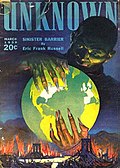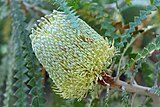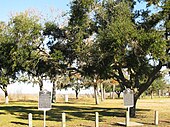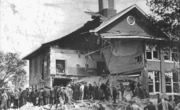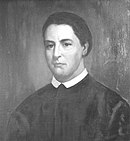| << | Today's featured articles for May 2020 | >> | ||||
|---|---|---|---|---|---|---|
| Su | Mo | Tu | We | Th | Fr | Sa |
| 1 | 2 | |||||
| 3 | 4 | 5 | 6 | 7 | 8 | 9 |
| 10 | 11 | 12 | 13 | 14 | 15 | 16 |
| 17 | 18 | 19 | 20 | 21 | 22 | 23 |
| 24 | 25 | 26 | 27 | 28 | 29 | 30 |
| 31 | ||||||
May 1
James A. Ryder (1800–1860) was an American Catholic priest who led several Jesuit institutions. He studied at Georgetown College before entering the Society of Jesus in 1815. Ryder was then sent to Italy, where he studied and taught theology. He continued as a professor upon his return to the United States in 1829, and became the president of Georgetown on May 1, 1840. He established the university's observatory and liquidated its debt, while gaining a reputation as a talented preacher. For two years of his term, he was also the provincial superior of the Jesuits' Maryland Province. In 1845, Ryder became the second president of the College of the Holy Cross. He then returned to Georgetown as president in 1848, where he oversaw construction of a new Holy Trinity Church and accepted a group of physicians to form a School of Medicine. Ryder then assisted in founding Saint Joseph's College in Philadelphia, and became its president in 1856. From 1857 until his death, he preached and did pastoral work. (Full article...)
May 2
The Waterloo Bay massacre was a clash between European settlers and Aboriginal Australians that took place on the cliffs of Waterloo Bay near Elliston, South Australia, in late May 1849. Part of the Australian frontier wars, it is likely that it resulted in the deaths of tens or scores of Aboriginal people. In the lead-up, three European settlers were killed by Aboriginal people, and one Aboriginal person was killed and five others were poisoned by European settlers. Local Aboriginal people have oral history traditions that a large-scale massacre occurred. While older European accounts suggest that the event was exaggerated into a myth over time, it has now been concluded that the stories are founded in fact, and that some form of punitive action did take place. In 2017, the District Council of Elliston erected a memorial (pictured) to acknowledge what occurred, and received a national award for their work in memorialising the massacre. (Full article...)
May 3
Catopsbaatar was a rodent-like mammal in the order Multituberculata that lived in what is now Mongolia during the Late Cretaceous epoch, about 72 million years ago. The first fossils were collected in the early 1970s, and the species received its own genus (Catopsbaatar, Greek and Mongolian for 'visible hero') in 1994. Five skulls, one molar, and one skeleton with a skull are known. The skull of Catopsbaatar was up to 70 mm (2.8 in) long, heavy-set and wide, with the zygomatic arches strongly expanded to the sides. The ankles had spurs like those of the male platypus and echidna, but apparently without the platypus's venom canal. The spurs of Catopsbaatar and other Mesozoic mammals may have been used for protection against theropod dinosaurs and other predators. Like other members of its order, this species probably gave live birth, and the presence of hair indicates it was warmblooded. Its fossils were found in the Red Beds of Hermiin Tsav and the Barun Goyot Formation in Mongolia. (Full article...)
May 4
Lactarius torminosus, the woolly milkcap, is a large agaric fungus. First described scientifically by Jacob Christian Schäffer in 1774, it is a common species, found in North Africa, northern Asia, Europe, and North America. It grows on the roots of various trees, most commonly birch in mixed forests. The cap of the L. torminosus mushroom, up to 10 cm (3.9 in) wide, is convex with a central depression. A blend of pink and ochre hues, the cap sometimes has concentric zones of alternating lighter and darker shades. On the underside are narrow flesh-colored gills, crowded closely together. The cylindrical stem is a pale flesh color with a delicately downy surface, up to 8 cm (3.1 in) long and 0.6–2 cm (0.2–0.8 in) thick. When cut or injured, the mushroom oozes a bitter white latex. The species is highly irritating to the digestive system when eaten raw, but is valued for its peppery flavor in Russia and Finland after being cooked to destroy its toxins. (Full article...)
May 5
God of War: Ascension is a 2013 action-adventure game developed by Santa Monica Studio and published by Sony Computer Entertainment for the PlayStation 3 console. Loosely based on Greek mythology, it is the seventh installment in the God of War series and prequel to the entire series. The player controls Kratos, the former servant of the Greek god of war Ares, who tricked Kratos into killing his own wife and daughter. In response to this tragedy, Kratos renounced Ares, breaking his blood oath to the god. He was then imprisoned and tortured by the three Furies, the guardians of honor and enforcers of punishment, who he confronts after escaping with the aid of Orkos. The gameplay is similar to previous installments, focusing on combo-based combat and quick time events. The game also features magical attacks, puzzles, and platforming elements. It is the only installment to include a multiplayer mode, which is online-only for both competitive and cooperative play. Ascension received generally favorable reviews from critics, although the story was deemed to be less compelling than previous entries. (This article is part of a featured topic: God of War franchise.)
May 6
Unknown was an American pulp fantasy fiction magazine, published from 1939 to 1943 and edited by John W. Campbell. Unknown was a companion to Astounding Science Fiction, also edited by Campbell; many authors and illustrators contributed to both. Campbell wanted to publish a fantasy magazine with more finesse and humor than Weird Tales, the leading fantasy magazine in the 1930s. Campbell required his authors to avoid simplistic horror fiction and insisted that the fantasy elements be developed logically. Notable stories included several well-received novels by L. Ron Hubbard and Fritz Leiber's "Two Sought Adventure", the first in his Fafhrd and the Gray Mouser series. Unknown was forced to a bimonthly schedule in 1941 by poor sales, and cancelled in 1943 when wartime paper shortages forced Campbell to choose between turning Astounding into a bimonthly or ending Unknown. The magazine is generally regarded as the finest fantasy fiction magazine ever published, despite the fact that it was not commercially successful. (Full article...)
May 7

Macedonia was an ancient kingdom on the periphery of Archaic and Classical Greece, and later the dominant state of Hellenistic Greece. The kingdom was founded and initially ruled by the Argead dynasty, followed by the Antipatrid and Antigonid dynasties. Home to the ancient Macedonians, it originated on the northeastern part of the Greek peninsula. Before the 4th century BC, it was a small kingdom outside of the area dominated by the city-states of Athens, Sparta and Thebes, and briefly subordinate to Achaemenid Persia. During the reign of the Argead king Philip II (359–336 BC), Macedonia subdued mainland Greece and the Thracians' Odrysian kingdom through conquest and diplomacy, and defeated Athens and Thebes in the Battle of Chaeronea. Philip's son, Alexander the Great, commanding the whole of Greece, destroyed Thebes after the city revolted. During Alexander's subsequent campaign of conquest, he overthrew the Achaemenid Empire and conquered as far as the Indus River. (Full article...)
May 8
The 1974 White House helicopter incident occurred when U.S. Army private Robert K. Preston stole a Bell UH-1B Iroquois helicopter (a "Huey") from Tipton Field, Maryland, and, in a major breach of security, landed it on the South Lawn (pictured) of the White House. Preston had enlisted in the Army to become a helicopter pilot, but did not graduate from the helicopter training course. Shortly after midnight on February 17, 1974, he was returning from leave when he took off in a helicopter. Preston flew towards Washington, D.C., where he hovered close to the Lincoln Memorial and Washington Monument and over the South Lawn of the White House. He then flew back towards Tipton Field, pursued by two police Bell 206 JetRanger helicopters. He returned to Washington, and again hovered over the South Lawn. The Secret Service opened fire; lightly wounded, Preston landed and was arrested. At his court-martial, he was sentenced to one year in prison and fined $2400. (Full article...)
May 9
USS Oberrender (DE-344) was a John C. Butler-class destroyer escort built for the United States Navy during World War II. She was named for Lieutenant Commander Thomas Olin Oberrender, Jr., the engineering officer of the light cruiser USS Juneau, killed when that ship was torpedoed and sunk during the Naval Battle of Guadalcanal. Laid down in November 1943, launched in January 1944, and commissioned almost four months later, Oberrender commenced convoy escort duty in the Pacific in late 1944, with an interlude protecting escort carriers during the early stages of the invasion of Leyte. She was heavily damaged by the explosion of the ammunition ship USS Mount Hood at Manus and was repaired there during November. Returning to service in December, Oberrender served on anti-submarine patrol during the Battle of Okinawa, during which she was irreparably damaged by a kamikaze attack in early May 1945. She was decommissioned and sunk as a target late that year. (Full article...)
May 10
Banksia speciosa, the showy banksia, is a large shrub or small tree in the family Proteaceae. First collected and described by Robert Brown in the early 19th century, the species occurs on the south coast of Western Australia between Hopetoun and the Great Australian Bight, growing on white or grey sand in shrubland. Reaching up to 8 m (26 ft) in height, it is a single-stemmed plant that has thin leaves with prominent triangular "teeth" along each margin, which are 20–45 cm (7.9–17.7 in) long and 2–4 cm (0.8–1.6 in) wide. The prominent cream-yellow flower spikes appear throughout the year, developing up to 20 follicles each that store seeds until opened by bushfire. Though widely occurring, the species is highly sensitive to dieback. The flowers attract nectar- and insect-feeding birds, particularly honeyeaters. In cultivation, B. speciosa grows well in a sunny location on well-drained soil in areas with dry summers. (Full article...)
May 11
The Sega Saturn is a 32-bit home video game console developed by Sega. Released in 1994 in Japan, and 1995 in North America and Europe, the Saturn is the successor to the Sega Genesis, and Sega's fourth game console. It has dual-CPU architecture and eight processors, and was designed around a CPU developed by electronics company Hitachi. Its games are in CD-ROM format. The system was initially successful in Japan, but failed to sell large numbers in the United States after a surprise launch four months before its scheduled release, and an aggressive price war against Sony's PlayStation. Following the release of the Nintendo 64 in late 1996, the Saturn rapidly lost market share in the U.S., and was discontinued in 1998 in the country. The console is considered a commercial failure, selling just over 9 million units worldwide, blamed in part due to Sega's failure to release a Sonic the Hedgehog video game, known in development as Sonic X-treme, for the system. (Full article...)
May 12
The Superliner is a type of bilevel intercity railroad passenger car used by Amtrak, the national rail passenger carrier in the United States. The design was based on Budd's Hi-Level vehicles, employed by the Santa Fe Railway on its El Capitan trains. Pullman-Standard built 284 cars, known as Superliner I (lounge pictured), from 1975 to 1981; Bombardier Transportation built 195, known as Superliner II, from 1991 to 1996. Car types include coaches, dining cars, lounges, and sleeping cars. Most passenger spaces are on the upper level, which features a row of windows on both sides. Boarding is on the lower level; passengers climb up a center stairwell to access the upper level. The first Superliner I cars entered service in February 1979, with deliveries continuing through 1981. Amtrak assigned the cars to both long-distance and short-distance trains in the Western United States. The first permanent assignment, in October 1979, was to the Chicago–Seattle Empire Builder. (Full article...)
May 13
"These Are the Voyages..." is the series finale of the American science fiction television series Star Trek: Enterprise. The episode, which first aired on the UPN network on May 13, 2005, is a frame story, where the 22nd-century events of Star Trek: Enterprise are recreated on a 24th-century holodeck on Enterprise-D from Star Trek: The Next Generation. Featuring guest stars Jonathan Frakes, Marina Sirtis, and Jeffrey Combs, the episode has Commander William Riker grappling with making a difficult admission to his commanding officer about a cover-up. Riker turns for guidance to the simulated events of the year 2161, when the crew of Enterprise travels home to Earth for the formation of the United Federation of Planets and Commander Trip Tucker, played by Connor Trinneer (pictured), saves the captain's life. UPN and Paramount had announced in February 2005 that the fourth season would be the show's last. Reaction to the series finale was negative, although it attracted 3.8 million viewers. (Full article...)
May 14
Spalding War Memorial is a First World War memorial in the gardens of Ayscoughfee Hall in Spalding, Lincolnshire, in eastern England. It was designed by Sir Edwin Lutyens. The proposal originated with Barbara McLaren; her husband Francis McLaren, the town's member of parliament, was killed during the war. Lutyens produced a plan for a cross in a grand memorial cloister surrounding a circular pond. The memorial was to be built in the hall's formal gardens, which were owned by the local council. After a public meeting and a vote in 1919, a reduced-scale version emerged as the preferred option. The memorial consists of a brick pavilion at the south end of the garden and a Stone of Remembrance, both at the head of a long reflecting pool (pictured). The design was not used in any of Lutyens's other war memorials but it influenced several of his cemeteries on the Western Front. The memorial was unveiled at a ceremony on 9 June 1922, and is a Grade I listed building. (Full article...)
May 15
Claudio Monteverdi (15 May 1567 – 29 November 1643) was an Italian composer, string player and maestro di cappella. A composer of both secular and sacred music, and a pioneer in the development of opera, he is considered a transitional figure between the Renaissance and the Baroque periods of music history. He was a court musician in Mantua (c. 1590 – 1613), and then maestro di cappella at St Mark's Basilica in the Republic of Venice. His surviving music includes nine books of madrigals, in the tradition of earlier Renaissance polyphony – but also experimenting with the basso continuo technique, distinctive of the Baroque – as well as large-scale sacred works, including the Vespro della Beata Vergine (Vespers for the Blessed Virgin), and three complete operas. His music enjoyed a rediscovery from the 1880s onwards, and he is now seen as a significant influence in European musical history. Seven of his operas have been lost, but his L'Orfeo (1607) is the earliest opera that is still widely performed. (Full article...)
May 16
Juan Davis Bradburn (1787–1842) was a brigadier general in the Mexican Army. His actions as commandant of the garrison at Anahuac (historical markers pictured) in Mexican Texas in 1831 and 1832 led to the events known as the Anahuac Disturbances. Born in the United States, he became an officer in the Mexican Army in 1821. In 1830, he established a new military and customs post at Anahuac in Texas. The local settlers resented Bradburn's efforts to withhold land titles from those who had dubious ownership, his attempts to enforce previously ignored customs laws, and his refusal to return fugitive slaves. A large force of Texians marched on Anahuac to secure the release of arrested settlers who had been denied protections offered by the United States Bill of Rights, even though these rights were not guaranteed in Mexico. The confrontation forced Bradburn's expulsion from Texas and encouraged further armed action against Mexican soldiers. (Full article...)
May 17
Frank Matcham (22 November 1854 – 17 May 1920) was an English theatre architect and designer. Matcham was best known for his work in London, under Moss Empires, which included the designs of the Hippodrome (1900), Hackney Empire (1901), Coliseum (1903), Palladium (1910), and the Victoria Palace (1911). During his 40-year career, he was responsible for the design and construction of over 90 theatres and the redesign and refurbishment of a further 80 throughout the United Kingdom. According to the dramatist Alan Bennett, there was a Matcham theatre in every corner of the UK. Matcham's use of cantilevers for the galleries allowed him to discontinue the use of columns, which would otherwise obstruct the audience's view of the stage. The auditorium decorations were often mixed with Tudor strap-work, Louis XIV detail, Anglo-Indian motifs, naval and military insignia, rococo panels, classical statuary, and baroque columns. (Full article...)
May 18
The Bath School disaster was a series of violent attacks perpetrated by Andrew Kehoe in Bath Township, Michigan. The attacks killed 38 elementary schoolchildren and 6 adults, and injured at least 58 other people. On the morning of May 18, 1927 – having previously murdered his wife at their farm – Kehoe set off almost simultaneous explosions at his home and at the Bath Consolidated School (pictured). His devices destroyed the farm's buildings and ripped through the north wing of the school. As rescuers began working at the school, Kehoe drove up to the schoolyard and set off dynamite inside his shrapnel-filled truck, killing himself and several others nearby. During the rescue and recovery efforts, searchers discovered 500 pounds (230 kg) of unexploded dynamite and pyrotol in the south wing of the school that had been set to detonate at the same time as the north wing explosions. (Full article...)
May 19
Peresvet was the lead ship of the three pre-dreadnought battleships of the Peresvet class built for the Imperial Russian Navy at the end of the nineteenth century. The ship was transferred to the Pacific Squadron upon completion and based at Port Arthur from 1903. During the Russo-Japanese War of 1904–05, she participated in the Battle of Port Arthur and was seriously damaged during the Battle of the Yellow Sea and again in the Siege of Port Arthur. The ship was scuttled before the Russians surrendered, then salvaged by the Japanese and placed into service with the name Sagami. Partially rearmed, Sagami was reclassified by the Imperial Japanese Navy as a coastal defence ship in 1912. In 1916, the Japanese sold her to the Russians, their allies since the beginning of World War I. En route to the White Sea in early 1917, she sank off Port Said, Egypt, after striking mines laid by a German submarine. (Full article...)
May 20
Aitraaz (Objection) is a 2004 Indian Hindi-language romantic thriller film directed by Abbas–Mustan. It stars Akshay Kumar and Priyanka Chopra (pictured), along with Kareena Kapoor Khan, Amrish Puri, Paresh Rawal and Annu Kapoor. It was produced by Subhash Ghai, with a screenplay by Shyam Goel and Shiraz Ahmed, and soundtrack by Himesh Reshammiya. In the film, a man is accused of sexual harassment by his female superior. It was released to positive reviews, and to widespread critical acclaim for Chopra's performance as Sonia Roy. Aitraaz was a commercial success, grossing over ₹260 million at the box office against a budget of ₹110 million. At the 50th Filmfare Awards, Chopra was nominated for Best Supporting Actress and won Best Performance in a Negative Role for her work. She also won the Bengal Film Journalists' Association Award for Best Actress and the Screen Award for Best Actor in a Negative Role. The film received ten nominations at the 2005 International Indian Film Academy Awards, winning three. (Full article...)
May 21
Marcel Lihau (1931–1999) was a Congolese jurist, law professor, and politician who helped create two constitutions for the Democratic Republic of the Congo. He attended the Université catholique de Louvain in Belgium, becoming one of the first Congolese to study law, and was made dean of the law faculty at Lovanium University in 1963. The following year, he helped deliver the Luluabourg Constitution, which the Congolese adopted by referendum. In 1965, Joseph-Desiré Mobutu seized control of the country and directed him to produce a new constitution. Lihau was First President of the new Supreme Court of Justice of the Congo from 1968 until 1975, when Mobutu summarily removed him from his post and placed him under house arrest. After Lihau helped found the reform-oriented Union pour la Démocratie et le Progrès Social, Mobutu suspended his rights and banished him to a rural village. Lihau eventually moved to the United States, where he continued to advocate for political reform in the Congo until his death. (Full article...)
May 22
The 1962 Tour de France was the 49th edition of the Tour de France, one of cycling's Grand Tours. The 4,274-kilometre (2,656 mi) race consisted of 22 stages, including two split stages, starting in Nancy on 24 June and finishing at the Parc des Princes in Paris on 15 July. For the first time since 1929, the Tour was contested by trade teams instead of national teams. Victory in the individual time trial of stage 20 put Jacques Anquetil (pictured) in the general classification leader's yellow jersey, which he held until the conclusion of the race to win his third Tour de France, defending his title. Jef Planckaert placed second, and Raymond Poulidor third. In the other race classifications, Rudi Altig won the points classification, and Federico Bahamontes won the mountains classification. Anquetil's team Saint-Raphaël–Helyett–Hutchinson won the team classification, and Eddy Pauwels won the award for most combative rider. Altig and Emile Daems won the most stages, with three each. (Full article...)
May 23
Anne Hathaway (born 1982) is an American actress. The recipient of multiple awards, she was one of the highest-paid actresses in the world in 2015, and her films have earned more than $6.8 billion worldwide. She made her breakthrough in The Princess Diaries (2001). After roles in the 2005 dramas Havoc and Brokeback Mountain, she played an assistant to a fashion magazine editor in The Devil Wears Prada (2006), and a recovering alcoholic in Rachel Getting Married (2008). She starred in the romantic films Bride Wars (2009), Valentine's Day (2010), and Love & Other Drugs (2010), and in the fantasy film Alice in Wonderland (2010). In 2012, Hathaway starred as Catwoman in The Dark Knight Rises and as Fantine in the musical drama Les Misérables, for which she won the Academy Award for Best Supporting Actress. She played a scientist in Interstellar (2014), the owner of an online fashion site in the comedy The Intern (2015), and a haughty actress in the heist film Ocean's 8 (2018). (Full article...)
May 24
On 24 May 1979, in a game against Worcestershire, Somerset County Cricket Club captain Brian Rose chose to declare his team's innings closed after one over, throwing the game to manipulate a loophole in the rules. He was aiming to avoid elimination on a strike rate tie-breaker from the quarterfinals of the 1979 Benson & Hedges Cup, a one-day cricket competition for counties in England and Wales. After Somerset scored one run and declared, Worcestershire scored the two runs they needed to win. The match at New Road (pictured) in Worcester was completed in 18 minutes, with only 16 legal deliveries. Although Somerset's declaration was within the Laws of Cricket, Rose was condemned by the press and cricket officials. Just over a week after the match, the Test and County Cricket Board met for an emergency session and voted to eject Somerset from the competition by a vote of seventeen to one. The Laws were later changed to ban declarations in professional one-day cricket. (Full article...)
May 25
Hurricane Fred was the easternmost Atlantic hurricane ever to form in the tropics, and the first to move through Cape Verde since 1892. The second hurricane of the 2015 Atlantic hurricane season, Fred became a Category 1 hurricane on August 31 as it approached Cape Verde, which was placed under a hurricane warning for the first time ever. The Barlavento Islands endured gales and flooding rains as the eye of the hurricane paralleled their shorelines. Structural damage across Boa Vista and Sal presented as leveled roofs, damaged homes and toppled utility poles. Farmers on São Nicolau suffered crop and livestock losses when they saw their lands flood. Fred's rains, though destructive, alleviated a drought across the Sotavento Islands of Cape Verde. Elsewhere, violent seas along the West African shoreline destroyed fishing villages and submerged homes in Senegal. Between the coasts of West Africa and Cape Verde, nine people died in maritime incidents. (Full article...)
May 26
Paul E. Patton (born May 26, 1937) is an American politician who served as the 59th governor of Kentucky from 1995 to 2003. He became wealthy operating coal mines for 20 years, then sold most of his coal interests in the late 1970s and entered politics. After serving briefly in the cabinet of Governor John Y. Brown Jr. and chairing the state Democratic Party, he was elected lieutenant governor in 1991. Four years later, he was elected governor over the Republican Party's Larry Forgy. The major achievement of Patton's first term was overhauling higher education, including making the state's community colleges and technical schools independent of the University of Kentucky and organizing them into the Kentucky Community and Technical College System. Because of a 1992 amendment to the Kentucky Constitution, he was the first governor eligible to succeed himself in office since James Garrard in 1800, and he was re-elected in 1999. (Full article...)
May 27
The Australasian Antarctic Expedition (1911–1914), headed by Douglas Mawson, explored the largely uncharted coast of Antarctica due south of Australia. Mawson was inspired to lead his own venture by his experiences on Ernest Shackleton's Nimrod expedition in 1907–1909. During its time in Antarctica, the Australasian Antarctic Expedition's sledging parties covered around 2,600 miles (4,180 km) of unexplored territory. Its ship, SY Aurora (pictured), navigated 1,800 miles (2,900 km) of unmapped coastline. Scientific activities included meteorological measurements, magnetic observations, an expansive oceanographic program, and the collection of many biological and geological samples, including the discovery of the first meteorite found in Antarctica. The expedition was the first to establish and maintain wireless contact between Antarctica and Australia. Its broad exploration program laid the groundwork for Australia's later territorial claims in Antarctica. (Full article...)
May 28
The great spotted woodpecker (Dendrocopos major) is a medium-sized woodpecker with pied black and white plumage and a red patch on the lower belly. Males and young birds also have red markings on the neck or head. This species is found across Eurasia and parts of North Africa, in all types of woodlands. Some individuals have a tendency to wander, leading to the recent recolonisation of Ireland. Great spotted woodpeckers chisel into trees to find food or excavate nest holes, and also drum for contact and territorial advertisement; they have anatomical adaptations to manage the physical stresses from the hammering action. They can extract seeds from pine cones and insect larvae from inside trees, and will eat eggs and chicks of other birds. Both parents incubate the clutch of four to six eggs and continue to feed the chicks for about ten days after they fledge. The species has a large population and is not threatened. (Full article...)
May 29
Pod is the debut album by American alternative rock band the Breeders, released by 4AD records on May 29, 1990. Engineered by Steve Albini, it features band leader Kim Deal (pictured) on vocals and guitar, Josephine Wiggs on bass, Britt Walford on drums, and Tanya Donelly on guitar. The Breeders formed in 1988 when Deal, a member of the Pixies, befriended Donelly of Throwing Muses during a European tour. They recorded a country-infused demo in 1989, leading to 4AD co-founder Ivo Watts-Russell funding an album, Pod, recorded that year at the Palladium studio in Edinburgh, Scotland. The album became a critical and popular success, reaching number 22 in the UK. Critics praised its dark, sexualized lyrics, and compared it favorably to the Pixies. Nirvana's Kurt Cobain said it was one of his favorite records, and Pitchfork ranked it number 81 on its list of the best albums of the 1990s. The cover art was designed by Vaughan Oliver and portrays a man performing a fertility dance while wearing a belt of eels. (Full article...)
May 30
Samuel Mulledy (1811–1866) was an American Catholic priest and Jesuit. Born in Virginia, he attended Georgetown College in Washington, D.C., where his brother, Thomas F. Mulledy, was the president. He then entered the Society of Jesus in 1831 and proved to be a good student. He was sent to Rome to study for the priesthood and to prepare for teaching. Upon his return, he held senior academic positions, culminating in his appointment as president of Georgetown College in 1845. Mulledy reluctantly accepted the position but requested to be relieved just eight months later. He continued to teach and minister, until his expulsion from the Jesuit order in 1850 due to alcoholism. For the next decade, he was a transient at churches in Massachusetts and New York, until being assigned to St. Lawrence O'Toole in New York City, where he remained for the rest of his life. On his deathbed, Mulledy successfully petitioned to be re-admitted to the Society of Jesus. (Full article...)
May 31
The British hydrogen bomb programme was the ultimately successful British effort to develop thermonuclear weapons. The successful test of an atomic bomb in Operation Hurricane in 1952 made Britain a nuclear power, but hopes that the United States would be sufficiently impressed to restore the Special Relationship were soon disappointed. In 1954, Cabinet agreed to proceed with the development of the hydrogen bomb. The scientists at the Atomic Weapons Establishment did not know how to build one, but produced three designs: Orange Herald, a large boosted fission weapon; Green Bamboo, an interim design; and Green Granite, a true thermonuclear design. The first series of Operation Grapple tests (newsreel featured) were hailed as a success, but Green Granite was a failure. In November 1957, they successfully tested a thermonuclear design. Subsequent tests demonstrated a mastery of the technology. Together with the Sputnik crisis, this resulted in the 1958 US–UK Mutual Defence Agreement, and the Special Relationship was restored. (Full article...)




